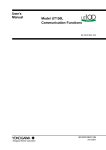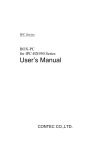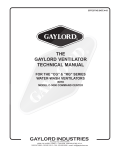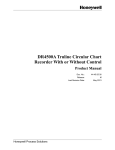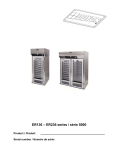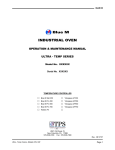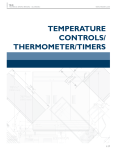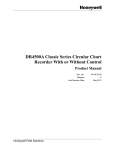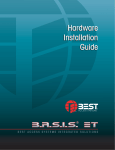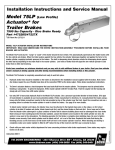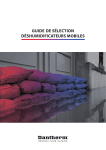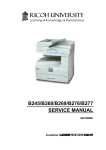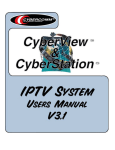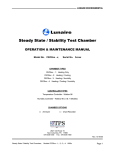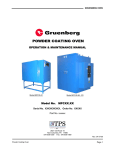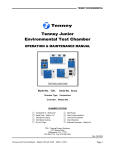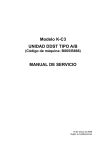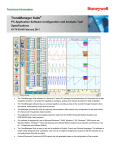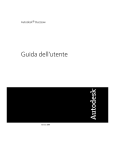Download INDUSTRIAL OVEN
Transcript
BLUE M INDUSTRIAL OVEN OPERATION & MAINTENANCE MANUAL DC 146 SERIES MODEL No. DCxxx S/N xxxxxxxxxx, O/N xxxxx TEMPERATURE CONTROLLER Blue M Stat 350 Yokogawa UT350 Blue M Pro 350 Yokogawa UP350 Blue M Pro 550 Yokogawa UP550 Blue M Pro 750 Yokogawa UP750 Watlow F4 2821 Old Route 15 New Columbia, PA 17856 570-538-7200 Fax: 570-538-7380 Rev. 04/21/11 Blue M - - DC 146 Series Industrial Ovens, Models DC, DCW, DCI, DCC Page 1 BLUE M THIS PAGE INTENTIONALLY LEFT BLANK Blue M - - DC 146 Series Industrial Ovens, Models DC, DCW, DCI, DCC Page 2 BLUE M TABLE OF CONTENTS SECTION Page INFORMATION 1.0 COMPANY INFORMATION & ASSISTANCE ____________________________________ 6 2.0 SAFETY WARNINGS & SYMBOLS ___________________________________________ 7,8 3.0 PRODUCT SPECIFICATIONS & OVERVIEW 3.1 3.2 3.3 3.4 Application & Specifications _________________________________________________ Conditioning Functions _____________________________________________________ Equipment and Control Features _____________________________________________ Operating Parameters and Requirements _______________________________________ 4.0 DRAWINGS, INFORMATION, and VENDOR INSTRUCTION LISTINGS ______________ 13 5.0 INSTALLATION INSTRUCTIONS 5.1 5.2 Delivery and Uncrating of Unit ________________________________________________ 14 Location and Installation of Unit ______________________________________________ 14 5.3 5.3.1 5.3.2 5.3.3 Equipment Access & Features Models DC & DCW ________________________________________________________ 15-17 Model DCI _______________________________________________________________ 18,19 Model DCC ______________________________________________________________ 20 5.4 5.5 5.6 5.7 5.8 5.9 5.10 5.11 Exhaust Connection (Models DC & DCW) _____________________________________ Water Supply Connections (for Cooling Coil - as applicable) ________________________ Inert Gas Supply Connection for Model DCI _____________________________________ Inert Gas Supply Connection for Model DCC ____________________________________ Chamber Venting for Models DCI & DCC _______________________________________ Compressed Air Supply Connection for Pneumatic Door Lock (Optional) ______________ Power Supply Specifications and Connection ____________________________________ Application of Power _______________________________________________________ Blue M - - DC 146 Series Industrial Ovens, Models DC, DCW, DCI, DCC 9 10 10-12 12 21 22 23,24 25,26 27 28 29-31 32 Page 3 BLUE M SYSTEMS and CONTROL 6.0 AIR CIRCULATION SYSTEM 6.1 6.2 System Overview _________________________________________________________ 33-35 Basic Workspace Airflow Description __________________________________________ 36-38 6.3 6.3.1 6.3.2 6.3.3 6.3.4 Adjustment of Air Intake & Exhaust Dampers for Model DC / DCW ___________________ One-Pass Airflow System ___________________________________________________ Full Recirculated Airflow System ______________________________________________ One-Pass & Full Recirculated Airflow Diagrams __________________________________ Adjustment of ASTM Air Intake & Exhaust Dampers ______________________________ 6.4 6.4.1 Airflow Description for Models DCI and DCC ____________________________________ 43 Model DCI & DCC Airflow Diagrams ___________________________________________ 43 6.5 HEPA & ULPA Filtration for Model DCC ________________________________________ 44,45 7.0 INERT GAS CONTROL SYSTEMS 7.1 7.2 Model DCI Gas Control System ______________________________________________ 46,47 Model DCC Gas Control System ______________________________________________ 48 8.0 OXYGEN ANALYZER / TRANSMITTER (Optional) 8.1 8.2 8.3 8.4 8.5 8.6 Overview ________________________________________________________________ Equipment Operation ______________________________________________________ Series 2000 / 2510 Percent Oxygen Units ______________________________________ Series 3000 / 3510 Trace Oxygen Units ________________________________________ Analyzer and Transmitter Equipment Differences _________________________________ Optional Inert Gas Injection Rate Control _______________________________________ 9.0 ELECTRIC HEATING SYSTEM & CONTROL ___________________________________ 51 10.0 COOLING SYSTEMS & CONTROL 10.1 10.2 Cooling with Ambient Air – Model DC / DCW ____________________________________ 52 Cooling with Water-Cooled Coil – Optional ______________________________________ 52 11.0 TEMPERATURE CONTROLLERS 11.1 11.2 11.3 Temperature Control _______________________________________________________ 53 Non-Profiling Type Controllers ________________________________________________ 53 Profiling Type Controllers – Optional ___________________________________________ 54,55 12.0 OVERTEMPERATURE PROTECTION ________________________________________ 56 Blue M - - DC 146 Series Industrial Ovens, Models DC, DCW, DCI, DCC 39,40 41 41 41 42 49 49 50 50 50 50 Page 4 BLUE M OPTIONAL EQUIPMENT and FEATURES 13.0 PROCESS TIMER – EAGLE SIGNAL B856 (Optional) ___________________________ 57 14.0 24 HR / 7 DAY DIGITAL TIMER – GRASSLIN DIGI 20E (Optional) __________________ 58 15.0 24 HR / 7 DAY DIGITAL TIMER – GRASSLIN FM1D (Optional) ____________________ 59 16.0 DOOR LIMIT SWITCH OPERATION (Optional) _________________________________ 60 17.0 ELECTRO - MECHANICAL DOOR LOCK OPERATION (Optional) __________________ 60 18.0 PNEUMATIC DOOR LOCK OPERATION ______________________________________ 61 19.0 LIGHT TOWER OPERATION ________________________________________________ 61 20.0 CHART RECORDER (Optional) _____________________________________________ 62 CHAMBER OPERATION & MAINTENANCE 21.0 SEQUENCE of OPERATION ________________________________________________ 63-67 22.0 PREVENTATIVE MAINTENANCE ____________________________________________ 68 22.1 22.2 Maintenance Checks / Procedures ____________________________________________ 68-70 Preventative Maintenance Schedule / Log ______________________________________ 71 SUPPLEMENTAL INSTRUCTIONS Blue M - - DC 146 Series Industrial Ovens, Models DC, DCW, DCI, DCC Page 5 BLUE M 1.0 COMPANY INFORMATION & ASSISTANCE Congratulations on purchasing a chamber from one of the fine divisions of TPS - Thermal Product Solutions. You probably already know us as Lunaire Limited. We’ve changed our name and expanded our vision with the intent to provide you with more diversified solutions to your thermal product process requirements. We truly hope that every aspect of chamber design and quality will measure up to your strictest standards. Your chamber has been designed to operate with the reliability you expect for the demands you impose on your product and research testing. Headquartered in New Columbia, Pennsylvania, which is located in the North-central part of the state, TPS includes the following five divisions that manufacture environmental test chambers and industrial ovens. Tenney Environmental - - - - Lunaire Environmental - - - - Gruenberg Oven - - - - Blue M - - - - Lindberg Parts and service inquiries for equipment within each division should be directed to TPS by any of the following methods. Important! Please have the Model and Serial Numbers of your unit available when contacting us. Model No. Serial No. Thermal Product Solutions PO Box 150 White Deer, PA 17887 Thermal Product Solutions 2821 Old Route 15 New Columbia, PA 17856 Phone: 570 - 538 - 7200 Fax - Parts Dept. 570 - 538 - 7385 Fax - Service Dept. 570 - 538 - 7391 Fax - Main: 570 - 538 - 7380 E - Mail Address: [email protected] Web site: www.thermalproductsolutions.com Mailing Address Physical Address Parts Replacement Your equipment has been designed and manufactured to provide years of reliable service. In the event a component should fail, it is recommended that only OEM approved parts be used as replacements. Please contact the Parts Department for component replacement, or repair. Blue M - - DC 146 Series Industrial Ovens, Models DC, DCW, DCI, DCC Page 6 BLUE M 2.0 SAFETY WARNINGS & SYMBOLS You must follow these and all Warning statements listed throughout the manual! 1. Read this entire Operation Manual, as well as the vendor manuals and cut-sheets provided before operating this equipment! Failure to adhere to any Safety Warning, or failure to follow the proper operating procedures listed throughout any of the information provided, could cause damage to your equipment, personal injury, or death. 2. Obey all “CAUTION”, “DANGER”, and “WARNING” signs / labels mounted on the equipment. Do not remove any of these signs / labels. 3. Do not use this equipment in any manner not specified in this manual. Improper use may impair the safety features employed and will void your warranty. 4. This equipment is NOT designed for use with volatile or explosive materials unless specifically stated in your purchase order. Loading of such materials may result in explosion or fire. 5. Operators and service personnel must be familiar with the location and function of all controls and the inherent dangers of the equipment before operating or maintaining it. 6. Only qualified service personnel should ever be permitted to perform any service-related procedure on this equipment! 7. Do not place the unit near combustible materials or hazardous fumes or vapors. 8. Do not install unit in a corrosive environment. A corrosive environment may lead to poor performance and deterioration of unit. 9. Make sure the chamber and any remote equipment provided are leveled when installed. The chamber door may swing shut on personnel if unit is tilted. 10. A main power disconnect switch is normally not provided with your unit. If not provided, we recommend that a fused disconnect switch on a separate branch circuit be installed as the power source in accordance with all National and Local Electrical Codes. 11. Do not position the chamber in a manner that would make it difficult to operate your main power disconnect switch. 12. Your power supply line voltage may be too low or too high to properly and safely operate your equipment. Before making the power supply connection to your equipment, you must follow the specific directions stated under “Power Supply Specifications and Connection” in the Installation Instructions section. Failing to perform the directions stated may damage your equipment and void your warranty! 13. Control panels, gauge boxes, the conditioning compartment, etc., contain exposed electrical connections. Keep panels in place properly when the unit is in operation. Disconnect and Lock-Out / Tag-Out all electrical power from the unit at its source before servicing or cleaning. 14. Do not adjust any mechanical components or any electrical components except as directed in this manual. 15. Do not modify any component on this unit. Use only original equipment manufactured (OEM) parts as replacement parts. Modifications to any component, or the use of a non-OEM replacement part could cause damage to your equipment, personal injury, or death. Blue M - - DC 146 Series Industrial Ovens, Models DC, DCW, DCI, DCC Page 7 BLUE M 16. Do not overload the floor of the chamber workspace or load the unit unevenly. 17. Do not exceed the temperature rating of your chamber. 18. Human exposure to temperature extremes can cause injury. Do not open oven doors until oven temperature drops below 200° F (93° C), when applicable. Take appropriate precautions before opening oven doors and upon handling any chamber contents. 19. Always cool the oven down below 167°F (75°C) before shutting it down. Otherwise, damage to the circulation motor shaft bearings will result. INTERNATIONAL WARNING / SAFETY SYMBOL DEFINITIONS Obey all “DANGER”, “WARNING”, and “CAUTION” labels shown in the manual and mounted on the equipment. Do not remove any labels mounted on the equipment. “WARNING OF HAZARDOUS AREA” “WARNING OF DANGEROUS ELECTRIC VOLTAGE” “WARNING OF HOT SURFACE” “EARTH (GROUND) PROTECTIVE CONDUCTOR TERMINAL” Blue M - - DC 146 Series Industrial Ovens, Models DC, DCW, DCI, DCC Page 8 BLUE M 3.0 3.1 PRODUCT SPECIFICATIONS & OVERVIEW Application & Specifications This manual applies to the Blue M Model 146 Series Industrial Ovens, which are designed in three distinct types and in a wide range of sizes. They serve a very diverse number of process applications. An electric heating system is used with a high volume air circulation system to provide maximum temperature uniformity. Model Type Model No. Workspace Temp. Rating Standard Models Model DC / DCW 1.6 to 24 Ft.3 15° above ambient to 350° C Inert Gas Models Model DCI 1.6 to 24 Ft.3 15° above ambient to 350° C Clean Room Models Model DCC 1.2 to 21.6 Ft.3 15° above ambient to 250° C Standard DC Models are the building block to the 146 Series with a proven high quality design and simple operation. Model DCW ovens are identical to the Model DC except that they incorporate a welded and sealed liner, which creates an impervious barrier between the process chamber and the insulation material. Inert Gas Model DCI ovens are utilized for processing materials in an inert atmosphere using a gas injection system. An inert atmosphere prevents oxidation from occurring on the product and eliminates the capability of oven air from supporting a flame. Clean Room Model DCC ovens employ a HEPA (or ULPA) filtration system to maintain Class 100 conditions in the oven workspace. An inert atmosphere is also maintained in the Model DCC. Model DCI and DCC ovens are constructed with an interior that is welded vapor tight. Special seals are installed on the door, blower shaft, and heater element terminals to ensure the sealed integrity. Workspace Capacity: A size code is given in the model number to indicate workspace capacity. Refer to the chart below. Important! For custom ovens with sizes not listed in this chart, the workspace will be given below. For S/N xxxxxxxxxx, O/N xxxxx, Model DCxxx, the workspace capacity is xxx cubic feet. WORKSPACE CAPACITY - SIZE CODE CHART MODEL DCxxx, WHERE xxx = SIZE CODE SIZE CODE CAPACITY (CUBIC FEET) 146 1.6 206 4.2 256 5.8 136 11.0 336 11.0 1406 24.0 1506 20.0 Blue M - - DC 146 Series Industrial Ovens, Models DC, DCW, DCI, DCC Page 9 BLUE M 3.2 Conditioning Functions Heating of the oven is achieved by recirculating oven air through open air nichrome wire heater elements mounted in the conditioning plenum. The plenum is located beneath the chamber workspace and is isolated to prevent direct heat radiation. Cooling in the Model DC oven is achieved by adjusting dampers with the intake and exhaust ports, which are normally located on the left side of the oven. Enhanced cooling is achieved by recirculating oven air through a water-cooled coil mounted in the conditioning plenum. This feature is optional in the Model DC, and standard in the Models DCI and DCC. Air flow is generated by a centrifugal type blower wheel mounted in the conditioning plenum. The blower wheel is directly driven by an externally mounted motor. A horizontal airflow type system is employed. For the Model DC, a portion of process air may be exchanged with fresh ambient air to remove moisture or undesirable process vapors. This is achieved by opening the intake and exhaust dampers. For the Model DC, the air intake and exhaust dampers can be adjusted to provide between a one-pass airflow system and a full recirculated airflow system within the chamber workspace. Inert gas systems employed with the Models DCI and DCC utilize a gas injection system that maintains an inert atmosphere in the oven during the entire process cycle. In the Model DCI only, an initial high purge cycle will remove oven ambient air before heating is allowed to begin. A constant low flow of gas will then be maintained during the heating and cooling cycles. Inert gas flow and chamber pressure are monitored and regulated with various instruments on the gas control panel. The following inert gases are approved for these ovens. 3.3 y Argon y Carbon Dioxide y Helium y Nitrogen Equipment and Control Features Temperature Control: For simple temperature control a non-profiling type controller is normally used. For temperature control with programming applications a profiling type controller is used. Available controllers are listed below. Non-Profiling Controller Models: (Non-Profiling Types Are Standard) Blue M Stat 350 / Yokogawa UT350 Profiling Controller Models: (Profiling Types Are Optional) Blue M Pro 350 / Yokogawa UP350 Blue M Pro 550 / Yokogawa UP550 Blue M Pro 750 / Yokogawa UP750 Watlow F4 Blue M - - DC 146 Series Industrial Ovens, Models DC, DCW, DCI, DCC Page 10 BLUE M Overtemperature Protection: A Yokogawa Model UT150L Limit Controller (OTP) is provided for overtemperature protection. The protection circuitry will shut down the heat control system and the circulation blower when a high heat limit is detected. Audible and / or visual alarms will be activated. Circulation Airflow Switches: A differential air pressure switch is used to monitor the generation of airflow by the circulation blower. A loss of airflow detected by the switch will result in a shutdown of the oven’s heaters and the activation of an alarm. Digital Process Timer - Optional: An Eagle Signal Model B856-500 Digital Process Timer may be provided to time your heat process cycle. The Model B856 is a programmable 1/16 DIN timer that features five selectable standard timing operations, with five selectable time ranges. The timer will start timing once the Timer Start pushbutton is pressed. When the total preset time has elapsed the timer will remove power from the heater(s). An audible alarm will sound. A Timer Reset button is provided to reset the system for the next cycle. 24 Hr. / 7 Day Digital Timer – Grasslin Digi20E - Optional: Note: The Grasslin Model Digi20E is being replaced by the Grasslin Model FM1D. A Grasslin Model Digi 20E Digital Timer may be provided, which features 24-hour or 7-day programming to start your process cycle. Up to 20 programs can be stored with up to 10 ON and 10 OFF Events per day. The timer also features a manual override. 24 Hr. / 7 Day Digital Timer – Grasslin FM1D - Optional: A Grasslin Model FM1D Digital Timer may be provided, which features 24-hour or 7-day programming to start your process cycle. Up to 20 programs can be stored with up to 10 ON and 10 OFF Events per day. The timer also features a manual override. Chart Recorder - Optional: A chart recorder may be provided to record temperature versus time. Recorders are normally a circular type with optional digital displays that indicate the actual temperature being recorded. A Type J thermocouple is used for temperature measurement. Blue M - - DC 146 Series Industrial Ovens, Models DC, DCW, DCI, DCC Page 11 BLUE M Oxygen Analyzer / Transmitter - Optional: An oxygen analyzer or transmitter may be employed in the Model DCC and DCI ovens. Percent oxygen instruments are used to measure oxygen as a percent of atmospheric volume within the chamber. Trace oxygen instruments are used to measure trace oxygen in ppm of atmospheric volume within the chamber. Analyzers are complete programmable type instruments with digital process displays. Transmitters transmit a 4-20 ma output signal to the main temperature controller to indicate oxygen levels. Both types will activate alarm circuitry and cause the shutdown of the heating system to prevent either an oxidizing condition or a potential explosive condition. Door Limit Switch – Optional: An oven door limit switch may be employed to enable the control circuitry only after the oven door is closed securely. Opening the door during the process cycle will shut down the heating system and the circulation blower motor. Electro-mechanical or Pneumatic Door Lock – Optional: Either an Electro-mechanical or a Pneumatic Door Lock may be provided to prevent the oven door from being opened after the process cycle has begun. An Event Output from a profiling type controller is used to lock the door with the start of the process. Additional Options: Blue M ovens are designed with the capability to incorporate many other optional features for safety purposes, enhanced process control, and simplified operator interface. Consult a Blue M Applications Engineer or our Service Department for more information or questions. And thanks for choosing a Blue M Oven! 3.4 Operating Parameters and Requirements This equipment is designed to operate safely when the following environmental conditions are met: Indoor use only. Within a temperature range of 5°C to 30°C (max). Maximum relative humidity 90%. The listed chamber specifications are based on operation at 24° C ambient temperature, altitude at sea level, and a 60 Hz power supply. Chamber operation utilizing a 50 Hz power supply may derate the listed performance specifications. Equipment damage, personal injury, or death may result if this equipment is operated or maintained by untrained personnel. Operators and service personnel must be familiar with the location and function of all controls and the inherent dangers of the equipment before operating or maintaining it. TPS shall not be liable for any damages, including incidental and/or consequential damages, regardless of the legal theory asserted, including negligence and/or strict liability. Observe all safety warnings and operating parameters listed in this manual, as well as all Caution, Danger, and Warning signs or labels mounted on the equipment to reduce the risk of equipment damage and personal injury. Blue M - - DC 146 Series Industrial Ovens, Models DC, DCW, DCI, DCC Page 12 BLUE M 4.0 DRAWINGS, INFORMATION, and VENDOR INSTRUCTION LISTINGS The following drawings are provided: Electrical Schematic xxxxxWD Wiring Parts List xxxxxPW General Layout (for custom ovens - when available) D001 The following information and vendor manuals are provided: Main Temperature Controller Manual Yokogawa UT150L Limit Controller Manual Optional Equipment – The following vendor manuals will be supplied when the option is included. Dial Set Purge Cycle Timer Manual for Model DCI Only - Eagle Signal B866-511 Digital Process Timer Manual - Eagle Signal B856-500 Day Timer Manual - Intermatic / Grasslin FM1D Series 24Hr / 7 Day (Qty. 2 - Installation & Programming) Chart Recorder Manual Oxygen Analyzer / Transmitter Manual - Alpha Omega Note: Various other vendor product information sheets may also be provided, which contain important operation and maintenance instructions. Their inclusion is subject to vendor availability. Note: Due to page volume or vendor availability, some manuals may only be included as an electronic copy on a CD. Blue M - - DC 146 Series Industrial Ovens, Models DC, DCW, DCI, DCC Page 13 BLUE M 5.0 INSTALLATION INSTRUCTIONS Read this section completely before attempting to install, or operate the equipment. 5.1 Delivery and Uncrating of Unit Inspect equipment and shipping crate immediately upon receipt. If any damage is apparent, you should discuss it with the trucking delivery person and contact the transportation company immediately. Make notes of any damage on the Bill Of Lading. Retain all shipping materials for inspection. Any claims for damage must start at the receiving point. Check packing slip carefully and make sure all materials have been received as indicated on the packing ticket. Unless otherwise noted, YOUR ORDER HAS BEEN SHIPPED COMPLETE. Chambers and any remote machinery skids or control cabinets should be handled and transported in an upright position. They must never be carried on their back, front, or any side. Important! Due to the vibration incurred during shipping and handling, it is possible that mechanical connections could become loose. Check all connections to make sure they are secure. 5.2 Location and Installation of Unit Standard Oven Classification: NFPA 86 Class B ovens are heat utilization equipment operating at approximately atmospheric pressure wherein there are no flammable volatiles or combustible material being heated in the oven. Do not place the unit near combustible materials or hazardous fumes or vapors. Do not install unit in a corrosive environment. A corrosive environment may lead to poor performance and deterioration of unit. Do not locate unit in areas of wide ambient temperature variation such as near vents or outdoor entrances. Ventilation: The oven should be installed in an area where there is good air ventilation. Allow a minimum of 5 inches between any wall and any oven side. Do not position the oven in a manner that would make it difficult to operate your main power disconnect switch. Make sure the oven is leveled when set up. The floor of the chamber should be leveled with a Spirit Level to +/- 1/8” (3.175 mm) front to back and side to side. Blue M - - DC 146 Series Industrial Ovens, Models DC, DCW, DCI, DCC Page 14 BLUE M 5.3 Equipment Access & Features 5.3.1 Models DC & DCW Models DC & DCW Exhaust Port Door Switch Intake Port Differential Air Pressure Switch Adjustment Port Main Circuit Breaker MODEL DC206 Thermocouple Ports Access Port Air Press. Sense Port Power Supply Junction Box MODEL DC206 - REAR Blue M - - DC 146 Series Industrial Ovens, Models DC, DCW, DCI, DCC Machinery Compartment Page 15 BLUE M Models DC & DCW Access Port Door Switch Main Circuit Breaker MODEL DC1406 Model DCW ovens incorporate a fully welded and sealed liner. This means that all port joints are welded around the entire perimeter. Note Weld 360° Around Port ACCESS PORT Blue M - - DC 146 Series Industrial Ovens, Models DC, DCW, DCI, DCC Page 16 BLUE M Models DC & DCW Chart Recorder Exhaust Port Thermocouple Ports Intake Port Air Pressure Sense Port Power Supply Junction Box Differential Air Pressure Switch Adjustment Port Machinery Compartment Panel Removed MODEL DC1406 - REAR Blue M - - DC 146 Series Industrial Ovens, Models DC, DCW, DCI, DCC Page 17 BLUE M 5.3.2 Model DCI Model DCI Chamber Pressure Relief Valve Inert Gas Control System & Supply Connection Differential Air Pressure Switch Adjustment Port MODEL DCI256 Door Switch Cooling Coil Water Supply Connection Oven Mounted on Stand Access Door MODEL DCI256 with STAND Blue M - - DC 146 Series Industrial Ovens, Models DC, DCW, DCI, DCC Page 18 BLUE M Model DCI Chamber Pressure Relief Valve Thermocouple Ports Inert Gas Control System & Supply Connection - Cover Removed Cooling Coil Water Supply Connection Air Press. Sense Ports Chart Recorder Light Tower Power Supply Junction Box Mach. Compartment Panel Removed Oven Stand MODEL DCI256 - REAR with STAND Differential Air Pressure Switch Adjustment Port MODEL DCI336 Blue M - - DC 146 Series Industrial Ovens, Models DC, DCW, DCI, DCC Page 19 BLUE M 5.3.3 Model DCC Model DCC Inert Gas Supply Flowmeter Oven Mounted on Stand T/C Ports Access Door MODEL DCC206 with STAND Air Press. Sense Ports Cooling Coil Water Supply Connection Power Supply Junction Box Diff. Air Press. Sw. Adjust. Port Inert Gas Supply Connection MODEL DCC206 - REAR with STAND Blue M - - DC 146 Series Industrial Ovens, Models DC, DCW, DCI, DCC Page 20 BLUE M 5.4 Exhaust Connection (Models DC & DCW) An exhaust port with a quad damper is installed on the left side of the Model DC oven. Exhaust port sizes range from 3” to 8” O.D., depending on oven size. An optional motorized damper actuator may be provided. For applications requiring protection from contacting hot surfaces of the oven exterior (U.L.), a wire mesh exhaust guard is installed around the exhaust port. For applications that require special temperature uniformity specifications (ASTM), an exhaust port with a scaled slide damper is provided. A special air intake port would be included. A vent duct should be connected to the exhaust port and run to a location outside of the building (as necessary). This should be done in accordance with all local code regulations. Make sure the connection is secure. Warning! Exhaust ports and vents can become extremely hot. Do not touch. Avoid contact between the port and flammable materials. Do not vent exhaust against combustible surfaces, areas, or materials. EXHAUST PORT with QUAD DAMPER EXHAUST PORT with GUARD ASTM EXHAUST PORT with SLIDE DAMPER Blue M - - DC 146 Series Industrial Ovens, Models DC, DCW, DCI, DCC Page 21 BLUE M 5.5 Water Supply Connections (for Cooling Coil - as applicable): Your oven will require a supply of city water for the water-cooled cooling coil, which is installed for the applications below. Optional for Model DC / DCW Standard for Models DCI and DCC The supply should be rated 3 - 4 GPM, 30 to 40 PSIG, at 75° F maximum. Water-In and Water-Out connections are located at the rear of the unit. Water Inlet Connection: The water inlet connection is made to the Cooling Coil solenoid valve and is a Type 3/8” Flare Fitting. Make sure your connection is secure. Water Outlet Connection: The water outlet / drain connection is made to a 1/2” O.D. stainless steel pipe. Your connection should be made with a clamped hose that runs to an open drain, which assumes there is no significant resistance to the flow of water, i.e., 0 PSIG "back pressure". CAUTION! Equipment damage hazard: Equipment damage will occur if back pressure is allowed to build up on water draining from coil. WARNING! Severe burn hazard: The use of the cooling coil to rapidly cool a high temperature oven (+100° C) will initially result in the emission of extremely hot steam from the water outlet / drain line. This steam can cause severe burns. Stay clear from drain when steam is emitted. WATER SUPPLY CONNECTIONS Blue M - - DC 146 Series Industrial Ovens, Models DC, DCW, DCI, DCC Page 22 BLUE M 5.6 Inert Gas Supply Connection for Model DCI An inert gas supply is required for process operation of the Model DCI. The selection of the approved gases listed below is primarily dependant upon compatibility with the materials being processed. Warning! This oven is designed for use with only the non-explosive, non-flammable, inert gases listed below. Operator injury and equipment damage may result if these instructions are not followed. The following inert gases are approved for the Models DCI and DCC. Argon Carbon Dioxide Helium Nitrogen Chamber Pressure Relief Valve The inlet connection is located inside the gas control housing on the left side of the oven. To access the connection you must first remove the housing cover. Caution! A manually operated shut-off valve and a reliable pressure regulator should be installed between your inert gas supply source and the oven connection. The gas supply should be regulated by the customer in the range from 40 to 70 PSIG maximum. The connection is Type 3/8” FPT. Make sure the connection is secure. The Purge Rate Adjustment needle valve on the flowmeter is used to adjust gas flow during the Purge Cycle. The Run Flow Adjustment Valve adjusts gas flow during the Run (Heat Process) Cycle. Refer to the Gas Flow Rate Table in Section 7.1 for the corresponding purge rates specified for your oven. You must adhere to the following warnings! INERT GAS CONTROL SYSTEM Warning! Suffocation hazard. The oven must be located in a well ventilated area. Although inert gases are not in themselves toxic, they can displace sufficient oxygen in poorly ventilated rooms to cause suffocation or asphyxiation. Warning! Burn Hazard. Avoid contact with cryogenic materials. Serious burns from immediate frostbite will result. Insulated gloves, eye goggles, and protective clothing MUST be worn when working with or around these materials. Gloves should be loose fitting so they can be quickly discarded in case liquefied gas spills or sprays into them. Blue M - - DC 146 Series Industrial Ovens, Models DC, DCW, DCI, DCC Page 23 BLUE M Do not connect oven directly to a compressed gas cylinder or any other high pressure gas source. Use only commercially prepared and bottled gases. Do not exceed 70 PSIG gas inlet pressure. Important! Refer to the Inert Gas Control System section for information on setting the flow rates for your chamber. Note: Gas Control Housing Is Removed Gas Supply Connection INERT GAS SUPPLY CONNECTION Blue M - - DC 146 Series Industrial Ovens, Models DC, DCW, DCI, DCC Page 24 BLUE M 5.7 Inert Gas Supply Connection for Model DCC An inert gas supply is required for process operation of the Model DCC. The selection of the approved gases listed below is primarily dependant upon compatibility with the materials being processed. Warning! This oven is designed for use with only the non-explosive, non-flammable, inert gases listed below. Operator injury and equipment damage may result if these instructions are not followed. The following inert gases are approved for the Models DCI and DCC. Argon Carbon Dioxide Helium Nitrogen The inlet connection is located at the rear right side of the oven. A gas Flowmeter is installed at the front of the oven with a Run Flow Adjustment needle valve. Caution! A manually operated shut-off valve and a reliable pressure regulator should be installed between your inert gas supply source and the oven connection. The gas supply should be regulated by the customer in the range from 40 to 70 PSIG maximum. The connection is Type 3/8” FPT. Make sure the connection is secure. Note: The size and / or SCFH rating of the gas flowmeter will increase with larger ovens. Front of Oven Rear of Oven Run Flow Adjustment INERT GAS SUPPLY CONNECTION Blue M - - DC 146 Series Industrial Ovens, Models DC, DCW, DCI, DCC GAS FLOWMETER Page 25 BLUE M You must adhere to the following warnings! Warning! Suffocation hazard. The oven must be located in a well ventilated area. Although inert gases are not in themselves toxic, they can displace sufficient oxygen in poorly ventilated rooms to cause suffocation or asphyxiation. Warning! Burn Hazard. Avoid contact with cryogenic materials. Serious burns from immediate frostbite will result. Insulated gloves, eye goggles, and protective clothing MUST be worn when working with or around these materials. Gloves should be loose fitting so they can be quickly discarded in case liquefied gas spills or sprays into them. Do not connect oven directly to a compressed gas cylinder or any other high pressure gas source. Use only commercially prepared and bottled gases. Do not exceed 70 PSIG gas inlet pressure. Important! Refer to the Inert Gas Control System section for information on setting the flow rates for your chamber. Blue M - - DC 146 Series Industrial Ovens, Models DC, DCW, DCI, DCC Page 26 BLUE M 5.8 Chamber Venting for Models DCI & DCC An inert atmosphere is maintained in the Model DCI and Model DCC ovens during the process cycle using an injected inert gas. Warning! Inert gases displace oxygen. A vent duct should be connected to the relief valve or vent port and run to a location outside of the building. This should be done in accordance with all local code regulations. Make sure the area surrounding the chamber is well ventilated. Warning! Exhaust ports and vents can become extremely hot. Do not touch. Avoid contact between the port and flammable materials. Do not vent exhaust against combustible surfaces, areas, or materials. Model DCI: A pressure relief valve (PRV) is installed with the Model DCI to cause a slight positive pressure to be established in the chamber during the process cycle. PRV is designed to open when chamber pressure rises above 0.5 PSIG. This valve is located at the top of the oven with a Type 1/2” FPT connection. Make sure the connection is secure. Oven Pressure Sense Line to Pressure Gauge PRV PRESSURE RELIEF VALVE & GAUGE Model DCC: A vent port is installed with the Model DCC to prevent any excess pressure buildup from occurring within the chamber. This port is located on top of the chamber with a Type 1/2" MPT connection. Make sure the connection is secure. VENT PORT Blue M - - DC 146 Series Industrial Ovens, Models DC, DCW, DCI, DCC Page 27 BLUE M 5.9 Compressed Air Supply Connection for Pneumatic Door Lock (Optional) A compressed air supply is required for operation of the pneumatic door lock system. The supply should be clean and dry and rated 25 to 40 PSIG maximum. The connection is made to a port located at the rear of the oven and is Type 1/4” FPT. Make sure the connection is secure. Pneumatic Door Lock Solenoid SOL1241 COMPRESSED AIR SUPPLY CONNECTION Blue M - - DC 146 Series Industrial Ovens, Models DC, DCW, DCI, DCC Page 28 BLUE M 5.10 Power Supply Specifications and Connection Standard Ovens: Refer to your Parts List or the Serial Tag attached to your unit for the power supply ratings. Special Ovens: For special oven Model Number xxxxxxxx, O/N xxxxx, the following ratings apply; xxx VAC, xx A, x PH, xx HZ Your main power fused disconnect switch should be rated xx Amps. Warning! Before making the power supply connection to your unit, you must perform the following procedure: 1. Verify the power supply voltage rating established for your chamber (listed above). The voltage rating is also found on the serial tag on the side of the oven. Note the rated value here: 2. Measure and record the intended voltage source. Note the measured value here: 3. Reference the “Line Voltage Min/Max Tables” below. Verify that the power supply voltage source you measured and recorded is within the minimum and maximum allowable operating voltages for your chamber voltage rating. If it is not within this operating range, do not make the power connection! Otherwise, erratic operation and damage may occur to your equipment, which may void your warranty. If you have any questions, please call the TPS Service Department. Important! One of the most common causes of equipment malfunction is low line voltage as the power source to the unit. Ordinarily in this condition, the heat output would be reduced and the system's motors would operate erratically, eventually overheat, and shut down. You must be certain that your equipment is connected to a circuit with an adequate voltage and current source. An oversupply voltage would also cause erratic operation and eventual shutdown, or damage to your equipment. - 60 HERTZ SUPPLIES - - 50 HERTZ SUPPLIES - LINE VOLTAGE MIN. / MAX. TABLE LINE VOLTAGE MIN. / MAX. TABLE Chamber Voltage Rating Minimum Voltage Maximum Voltage Chamber Voltage Rating Minimum Voltage Maximum Voltage 208 188 228 200 180 220 230 207 253 220 198 242 460 414 506 380 342 418 480 432 528 400 360 440 415 374 456 60 Hz Supply Operation outside these limits can result in damage to chamber equipment. 50 Hz Supply Blue M - - DC 146 Series Industrial Ovens, Models DC, DCW, DCI, DCC Operation outside these limits can result in damage to chamber equipment. Page 29 BLUE M Making the Power Supply Connection to the Chamber: A main power disconnect switch is normally not provided with your chamber. We recommend that a fused disconnect switch on a separate branch circuit be installed as the power source to your chamber, in accordance with all national and local electrical codes. Reference your Electrical Schematic or your serial tag for all electrical requirements. The power supply connection is made to the main power cables inside the power supply junction box located at the rear left side of the oven. Warning! High Accessible Current – An Earth connection is essential before connecting the power supply. Make sure equipment is properly grounded in accordance with all codes. Warning! Make sure that all electrical wiring is properly installed in accordance with all National and Local Electric Codes. Make sure all connections are secure. Machinery Section Rear Views: Rear views of machinery sections are shown for a range of oven sizes from large to small. These include the Models DC1406, DC336, and DCC206. Model DC1406 Power Supply Junction Box Heater Connections Main Circuit Breaker Control Panel Assembly Circ. Motor Diff. Air Press. Sw. Heater Power SSRs MACHINERY SECTION – MODEL DC1406 Blue M - - DC 146 Series Industrial Ovens, Models DC, DCW, DCI, DCC Page 30 BLUE M Model DC336 Power Supply Junction Box Control Panel Assembly Diff. Air Press. Sw. Heater Connections Circ. Motor Heater Power SSRs Main Circuit Breaker MACHINERY SECTION – MODEL DC336 Model DCC206 Power Supply Junction Box Control Panel Assembly Diff. Air Press. Sw. Heater Connections Circ. Motor Main Circuit Breaker Heater Power SSRs Inert Gas Inlet MACHINERY SECTION – MODEL DCC206 Blue M - - DC 146 Series Industrial Ovens, Models DC, DCW, DCI, DCC Page 31 BLUE M 5.11 Application of Power Before energizing any equipment, make a visual inspection for loose components, electrical connections, fittings, etc. Shut all operating switches to the “OFF” position before energizing. Have trained personnel start and check out the equipment before its first cycle. Motor Rotation Check: Units with three phase motors must be checked to insure proper motor rotation. A red arrow is located on the motor housing of three phase motors to show proper rotation. If it is opposite, shut down the oven and disconnect the main power supply source. Perform Lock-Out / Tag-Out Procedures established by your company. Reverse two of the line feeds to obtain proper operation. Failure to check motor rotation may result in DAMAGE TO THE EQUIPMENT due to opposite airflow, or no airflow. Blue M - - DC 146 Series Industrial Ovens, Models DC, DCW, DCI, DCC Page 32 BLUE M 6.0 6.1 AIR CIRCULATION SYSTEM System Overview A high volume horizontal type airflow system is employed with an electrical heating system to provide maximum temperature uniformity. Heating and the generation of airflow occurs in the conditioning plenum located below the workspace floor. The plenum is isolated from the workspace to prevent direct heat radiation. Air circulation is generated by a centrifugal type blower wheel that is driven by an externally mounted motor. The water-cooled cooling coil, which is optional for the Model DC / DCW and standard for the Models DCI and DCC, is installed in the conditioning plenum to the right of the electric heaters. Standard units employ perforated duct walls to permit air circulation through the workspace. Special units that require temperature uniformity requirements will employ semi-pierced duct walls. A horizontally placed air diffuser panel is installed in the right side duct wall to uniformly direct airflow upwards. For Models DC / DCW, adjustable air intake and exhaust dampers / ports are installed on the left side of the oven to enable the exchange of process air with fresh ambient air. These ports can be opened for the purpose of either cooling or to remove undesirable process vapors or moisture. They can also be adjusted to provide between a one-pass airflow system and a full recirculated airflow system in the workspace. For Models DCI and DCC, inert gas is injected into the conditioning plenum, replacing ambient atmospheric air for the complete process cycle. A pressure relief valve for the Model DCI and a vent port for the Model DCC are installed to vent the chamber. Type J Thermocouples are placed in the workspace airflow at the top rear wall to measure temperature with the main and limit controllers. Model DCW1406 Exhaust Port Air Diffuser Air Intake Damper in Closed Position Differential Air Pressure Sense Tube Discharge Air Blower Wheel Heaters CONDITIONING PLENUM – MODEL DCW1406 Blue M - - DC 146 Series Industrial Ovens, Models DC, DCW, DCI, DCC Page 33 BLUE M Model DCC336 Air Diffuser Thermocouple Ports Water-Cooled Coil Diff. Air Press. Sense Tubes Inert Gas Port Below Wheel Discharge Air Blower Wheel Heaters CONDITIONING PLENUM – MODEL DCC336 Model DC256 Exhaust Port Air Diffuser Air Intake Damper in Closed Position Access Port Diff. Air Press. Sense Tube Discharge Air Blower Wheel Heater CONDITIONING PLENUM – MODEL DC256 Blue M - - DC 146 Series Industrial Ovens, Models DC, DCW, DCI, DCC Page 34 BLUE M Model DCC256 Differential Air Pressure Sense Tubes Blower Discharge MODEL DCC256 BLOWER DISCHARGE Models DC & DCI Thermocouples Rear Wall THERMOCOUPLE LOCATION – MODELS DC & DCI Thermocouples Model DCC Note: Thermocouples are placed along the left wall in the Model DCC only, due to the Clean Room Insert that is installed inside the oven liner. THERMOCOUPLE LOCATION – MODEL DCC Blue M - - DC 146 Series Industrial Ovens, Models DC, DCW, DCI, DCC Page 35 BLUE M 6.2 Basic Workspace Airflow Description Process air is drawn down into the conditioning plenum from along the left side duct wall by the circulation blower wheel. For Models DC / DCW, this air will mix with fresh ambient intake air when the intake damper is opened. The air is forced through the heaters and the water-cooled cooling coil (when employed), and is discharged up into the right side duct wall. Conditioned air enters the workspace through either pierced or semi-pierced openings over the entire height and depth of the workspace. The air flows in a horizontal pattern from right to left to condition the product, and exits through pierced openings in the left side duct wall. Process air returns to the conditioning plenum and the cycle continues. For Models DC / DCW, a portion of process air can be exhausted out through the exhaust port when the exhaust damper is opened. Model DCW1406 Thermocouples Access Port WORKSPACE AIRFLOW – MODEL DCW1406 Blue M - - DC 146 Series Industrial Ovens, Models DC, DCW, DCI, DCC Page 36 BLUE M Model DC336 Thermocouples Access Port WORKSPACE AIRFLOW – MODEL DC336 Blue M - - DC 146 Series Industrial Ovens, Models DC, DCW, DCI, DCC Page 37 BLUE M Thermocouples Model DC206 Access Port WORKSPACE AIRFLOW – MODEL DC206 Differential Air Pressure Switches (FLS): A differential air pressure type switch is utilized to monitor for correct operation of the circulation blower motor. Correct rotation of the motor is necessary for the switch to properly operate. This device uses a diaphragm to sense pressure and to mechanically trigger a SPDT Snap Switch when the correct pressure is developed across the blower wheel. Note: The air pressure switch in the Model DC / DCW measures differential pressure between ambient air and the inlet of the blower wheel. Note: Air pressure switches in the Models DCI and DCC measure differential pressure between the inlet and outlet (discharge) of the blower wheel. DIFFERENTIAL AIR PRESSURE SWITCH If a loss of pressure / airflow were detected, the switch would open causing power to be removed from the heaters. Audible or visual alarms will be activated (when employed). Loss of airflow may result from a motor malfunction, reversed motor rotation, a loose blower wheel, reversed air sensor tubes, or a clogged HEPA filter (when applicable). Important Note: Do not tamper with the airflow switch adjustment port located at the side of the unit. The switch is factory preset. Note: Your equipment configuration may be slightly different from what is shown. Blue M - - DC 146 Series Industrial Ovens, Models DC, DCW, DCI, DCC Page 38 BLUE M 6.3 Adjustment of Air Intake & Exhaust Dampers for Model DC / DCW Adjustable air intake and exhaust dampers permit the air circulation system to be operated between a onepass airflow system and a full recirculated airflow system. Both dampers should be slightly opened for the following conditions. To remove undesirable process moisture and vapors generated by the heating process. To promote faster drying times. When operating near ambient temperature. Cooling with the heating system turned off. The blower wheel generates additional heat due to air friction as it rotates at high speed. This additional heat can not be controlled by the main temperature controller. Both dampers should be opened wider as you operate closer to ambient temperature to purge the extra heat produced. Standard Air Intake Damper: The intake damper includes a pivot assembly with a linkage to the damper blade. You must loosen the knob to slide the pivot assembly right or left, which opens and closes the damper. A damper setting scale is indented into the frame. It is marked “Closed, 1, 2, 3, Open”. Make sure you tighten the knob after changing the setting. Indented Scale Note: The indented scale is marked for reference only. There is no related unit of measure tied this scale. ADJUSTABLE AIR INTAKE DAMPER Rod Attached to Back of Damper Blade Threaded Rod Damper Blade ADJUSTABLE AIR INTAKE DAMPER DAMPER BLADE Blue M - - DC 146 Series Industrial Ovens, Models DC, DCW, DCI, DCC Page 39 BLUE M Standard Air Exhaust Damper: The exhaust damper includes a lever attached to the damper shaft. You must loosen the wingnut on the shaft assembly to open and close the butterfly damper. An indented “Open” to “Shut” scale is marked with graduated lines on the assembly. Make sure you tighten the wingnut after changing the setting. Wingnut Note: The indented marks are for reference only. There is no related unit of measure. Indented Marks ADJUSTABLE AIR EXHAUST DAMPER Optional Motorized Air Exhaust Damper: The Belimo Model NMB Motorized Damper Actuator may be employed to automatically open and close the air exhaust damper. Several methods of control are available. Standard units utilized a manual toggle switch on the main control panel. Profiling type controllers may use either an Event Output or a 4-20 ma proportioned type control signal. EXHAUST DAMPER ACUTATOR Optional Motorized Air Intake Damper: The Belimo Model NMB Motorized Damper Actuator may be employed to automatically open and close the air intake damper. This device is installed at the rear of the chamber with a special damper connecting rod assembly that attaches to the top flange of the damper blade. Several methods of control are available. Standard units utilized a manual toggle switch on the main control panel. Profiling type controllers may use either an Event Output or a 4-20 ma proportioned type control signal. . INTAKE DAMPER ACUTATOR Blue M - - DC 146 Series Industrial Ovens, Models DC, DCW, DCI, DCC Page 40 BLUE M 6.3.1 One-Pass Airflow System To operate with a One-Pass Airflow System, the air intake and exhaust dampers must be fully opened. When the intake damper is fully opened, it will totally close off the recirculation path to the conditioning plenum from the left duct wall. Fresh ambient air will be drawn into the blower wheel inlet and then heated as it is forced through the heater bank. Heated air will be discharged up into the right duct wall and into the workspace. It flows horizontally across the workspace to condition the product and exits through the left duct wall. Since the recirculation path is blocked by the intake damper, 100% of all process air is forced out of the exhaust port. No air is recycled. This system will permit fast drying times, purge process vapors, and allow near ambient operation. 6.3.2 Full Recirculated Airflow System To operate with a Full Recirculated Airflow System, both the intake and exhaust dampers must be fully closed. 100% of chamber air will be recirculated. This system allows rapid heat up rates and better temperature uniformity than with the One-Pass System. 6.3.3 One-Pass & Full Recirculation Airflow Diagrams Front View Front View Exhaust Damper Fully Opened Exhaust Damper Fully Closed Intake Damper Fully Opened Intake Damper Fully Closed Blower Wheel Heater ONE-PASS AIRFOW FULL RECIRCULATED AIRFLOW Important Note: The airflow diagrams shown above also apply to the Model DC and DCW Ovens when the ASTM air intake and exhaust ports are employed. The only differences in the diagrams would be the drawing of the dampers themselves. Blue M - - DC 146 Series Industrial Ovens, Models DC, DCW, DCI, DCC Page 41 BLUE M 6.3.4 Adjustment of ASTM Air Intake & Exhaust Dampers For applications that require special temperature uniformity requirements according to ASTM specifications, special air intake and exhaust dampers are employed. ASTM Intake Damper: The ASTM air intake damper is provided with a cover that can only be positioned either fully open or fully closed. A threaded rod is welded to the inside of the cover with the threaded portion passing through a welded crossbar inside the exhaust port. A silicone gasket is attached to the inside of the cover. This gasket provides a 100% sealed port with the cover positioned tight against the port perimeter. To open the port, rotate the knob on the intake cover counterclockwise. To close the port, rotate the knob on the intake cover clockwise. ASTM INTAKE DAMPER ASTM Exhaust Damper: The ASTM exhaust slide damper is adjusted using the marked scale by simply pushing the slide in and out. Please note that the slide fits very snug within the assembly to insure a tight seal. The slide damper is shown fully closed in the photo. ASTM EXHAUST DAMPER Blue M - - DC 146 Series Industrial Ovens, Models DC, DCW, DCI, DCC Page 42 BLUE M 6.4 Airflow Description for Models DCI and DCC In the Model DCI and DCC ovens, inert gas is injected into the conditioning plenum below the inlet of the blower wheel. The gas mixes with circulating process air and is forced through the heaters and the watercooled cooling coil, and is discharged up into the right side duct wall. Conditioned air enters the workspace through either pierced or semi-pierced openings over the entire height and depth of the workspace. The air flows in a horizontal pattern from right to left to condition the product, and exits through pierced openings in the left side duct wall. Process air returns to the conditioning plenum and the cycle continues. In the Model DCC only, the air will pass through a HEPA / ULPA filter before entering the workspace. Chamber Venting: To insure than an overpressure condition does not develop within the chamber, a vent port is installed in the chamber ceiling. For the Model DCI, a Pressure Relief Valve PRV is installed on the vent port atop the chamber. PRV will automatically open when chamber pressure reaches 0.5 PSI. Slight chamber pressures up to 0.5 PSI will not adversely affect the integrity of the oven door seal. For the Model DCC, a PRV is not installed on the vent port. It is left open to vent continuously. 6.4.1 Model DCI & DCC Airflow Diagrams Pressure Relief Valve Vent Port HEPA Filter Gas Control Panel Blower Wheel Inert Gas Inlet Cooling Coil Heater Inert Gas Inlet Cooling Coil Flowmeter INERT GAS MODEL AIR FLOW Blue M - - DC 146 Series Industrial Ovens, Models DC, DCW, DCI, DCC CLEAN ROOM MODEL AIR FLOW Page 43 BLUE M 6.5 HEPA & ULPA Filtration for Model DCC Either HEPA filtration or ULPA filtration is employed in the Model DCC to maintain clean room specifications. The filter is installed behind the right side duct wall. Discharge air from the conditioning plenum enters the filter before flowing out into the workspace. • HEPA (High Efficiency Particulate Air) filters are rated 99.97% efficient at 0.3 microns. • ULPA (Ultra Low Particulate Air) filters are rated 99.99% efficient at 0.12 microns. A stainless steel Clean Room Insert frame is installed in the oven which houses the HEPA and ULPA filters. The insert encompasses the workspace of the oven with the filter mount on the right wall and return air flow perforations on the left wall. The insert floor covers the bottom conditioning plenum. Filters can be changed without removing the insert. To access the conditioning plenum for maintenance purposes, the insert must be removed. It can also be removed for cleaning. Model DCC206 ULPA FILTER Screen & Shelf Slides Installed MODEL DCC206 CLEAN ROOM INSERT MODEL DCC206 – INSERT INSTALLED Blue M - - DC 146 Series Industrial Ovens, Models DC, DCW, DCI, DCC Page 44 BLUE M Model DCC1406 Screen & Shelf Slides Installed MODEL DCC1406 CLEAN ROOM INSERT REMOVED with HEPA INSTALLED INSERT with HEPA INSTALLED – INSIDE VIEW Model DCC336 Screen & Shelf Slides Installed MODEL DCC336 with HEPA FILTER DCC336 with SCREEN / SHELF HOLDER Blue M - - DC 146 Series Industrial Ovens, Models DC, DCW, DCI, DCC Page 45 BLUE M 7.0 7.1 INERT GAS CONTROL SYSTEMS Model DCI Gas Control System An inert gas sytem is used to maintain an inert atmosphere in the oven at a slight positive pressure during the entire process cycle. The oven is initially purged of atmospheric air for a specific time period before heating is allowed to begin. A constant flow of inert gas is then maintained during the heating and cooling cycles. Inert gas flow and chamber pressure are monitored and regulated with various instruments on the front control panel. The gas is injected into the chamber through a small port located beneath the blower wheel in the conditioning plenum. The following inert gases are approved for this oven. • Argon • Carbon Dioxide • Helium • Nitrogen Warning! This oven is designed for use with only non-explosive, non-flammable, inert gases. Operator injury and equipment damage may result if all safety precautions are not followed. Initial Chamber Purge Cycle: Before the process cycle is allowed to begin, a chamber purge cycle is initiated which lasts for a set amount of time dependent on oven size and purge rate. These values are listed in the Gas Flow Rate Table below. The purge cycle is designed to purge the chamber of existing atmospheric air in the chamber and replace it with an inert gas. All oxygen, water vapor, airborne contaminants, etc., are removed. We recommend that a volume of inert gas at least 5 to 10 times the volume of the work chamber be forced through the oven. The Gas Flow Rate Table reflects a rate of approximately 7 times the volume for the chamber listed. The Purge Rate Adjustment needle valve on the flowmeter is used to adjust gas flow during the Purge Cycle. This would also be the maximum flow allowed. Please note that your process may require a slight variation. Gas Flow Rate Table MODEL PURGE FLOW RATE PURGE TIME RUN FLOW RATE COOL DOWN FLOW RATE DCI -146 100 SCFH 11 min. 20 SCFH Same as Run Rate DCI -206 100 SCFH 27 min. 25 SCFH Same as Run Rate DCI -256 200 SCFH 18 min. 30 SCFH Same as Run Rate DCI -136 200 SCFH 30 min. 60 SCFH Same as Run Rate DCI -336 200 SCFH 30 min. 60 SCFH Same as Run Rate DCI -1406 600 SCFH 25 min. 120 SCFH Same as Run Rate Important! Make sure the Purge Flow Rate is maintained during each purge cycle. Blue M - - DC 146 Series Industrial Ovens, Models DC, DCW, DCI, DCC Page 46 BLUE M The Eagle Signal Model B866-511 Purge Timer is used to time the purge cycle. This timer is installed inside the control panel. After product is loaded, the oven door is securely closed, and the chamber is started, the timer will immediately energize and open the Gas Purge solenoid valve to start the purge. The circulation blower will start and the heating system will be disabled. Note: The purge timer will reset each time the door is opened. A pressure relief valve PRV is installed to insure that an overpressure condition does not develop, while maintaining a slight positive chamber pressure. PRV is designed to open at 0.5 PSIG. A chamber pressure gauge is installed on the gas control panel. EAGEL SIGNAL B866-511 WARNING! NEVER ALLOW CHAMBER PRESSURE TO EXCEED 1.0 PSIG. Reduce the flow rate immediately if this occurs. Check the PRV valve for cleanliness if problem persists. Run (Heat Process) Cycle: After the purge cycle has been completed, the purge timer output will open to deenergize and close the Gas Purge solenoid valve. The inert gas supply will now flow into the chamber through the Run Flow Adjustment valve on the gas control panel. Make sure you adjust this valve to the corresponding Run Flow Rate for your chamber listed in the Gas Flow Rate Table. This flow level maintains a slightly positive pressure in the chamber during the heat process cycle. One or two ounces per square inch (2 or 3 inches of water column) should be sufficient. The heating circuitry will now be enabled to start the heat process cycle. Important! Make sure the Run Flow Rate is maintained during the entire Run (Heat Process) Cycle. Note: The pressure indicated on the gauge may vary during different portions of the cycle. The pressure will increase as the temperature rises and decrease when the temperature drops. Needle Valve Cool Down Cycle: Upon completion of the heat process cycle the heating system will be disabled. During the Cool Down Cycle, the inert gas atmosphere must be maintained until the work load is below the temperature at which oxidation will occur. 125° C is considered the highest safe temperature for most workloads. The Cool Down Flow Rate is identical to the Run Flow Rate listed for your chamber in the Gas Flow Rate Table. Note: When processing high mass loads the work load temperature may be higher than the temperature shown on the temperature indicator. GAS CONTROL PANEL Blue M - - DC 146 Series Industrial Ovens, Models DC, DCW, DCI, DCC Page 47 BLUE M 7.2 Model DCC Gas Control System An inert gas sytem is used to maintain an inert gas atmosphere in the oven during the entire process cycle. The Model DCC does not incorporate a separate Purge Cycle and Run Cycle as in the Model DCI. Therefore, the pressure relief valve, pressure gage, and purge timer are not employed. Inert gas is injected into the chamber through a small port located beneath the blower wheel in the conditioning plenum. The following inert gases are approved for this oven. • Argon • Carbon Dioxide • Helium • Nitrogen Warning! This oven is designed for use with only non-explosive, non-flammable, inert gases. Operator injury and equipment damage may result if all safety precautions are not followed. A vent port is located on the top of the oven to vent process air, insuring that excess chamber pressure levels do not develop to violate the oven door seal integrity. The pressure is not monitored or controlled and is a result of gas injection flow rate versus gas vent dynamics. This may be affected by excess loading of the HEPA / ULPA filter. Flow rate is adjusted using the needle valve on the flowmeter. Needle Valve GAS FLOWMETER Blue M - - DC 146 Series Industrial Ovens, Models DC, DCW, DCI, DCC Page 48 BLUE M 8.0 8.1 OXYGEN ANALYZER / TRANSMITTER (Optional) Overview When an inert gas atmosphere is employed (Model DCI & DCC), it may be necessary to monitor the amount of oxygen present in the chamber atmosphere for safety or process control reasons. In an alarm condition, the heating system would be shut down and audible /visual alarms will be activated. One of the following Alpha Omega Oxygen Analyzers / Transmitters may be employed. 8.2 Series 2000 Percent Oxygen Analyzer Series 2510 Percent Oxygen Transmitter Series 3000 Trace Oxygen Analyzer Series 3510 Trace Oxygen Transmitter Equipment Operation The analyzer / transmitter samples process air through a line that runs from the pressure relief valve fitting with Model DCI ovens, or from the vent port fitting with Model DCC ovens. Both fittings are on top of the oven. A flowmeter provides indication of the sample flow rate experienced by the analyzer / transmitter unit. The units employ a sensor which is a lead-oxygen battery consisting of a gold plated cathode and a lead anode fully self-contained in an electrolyte solution. As a small amount of oxygen permeates through a Teflon membrane of the sensor it is reduced electro-chemically at the gold electrode. A resistor and a thermistor (for temperature compensation) are connected between the cathode and anode. As a result, the lead oxygen battery is always discharged. Current flowing through the resistor and thermistor is proportional to the oxygen concentration of the gas in contact with the Teflon membrane. By measuring the voltage between the resistor and thermistor, oxygen concentration can be accurately determined. Flowmeter SERIES 2000 PERCENT ANALYZER SERIES 3510 TRACE OXYGEN TRANSMITTER Blue M - - DC 146 Series Industrial Ovens, Models DC, DCW, DCI, DCC Page 49 BLUE M 8.3 Series 2000 /2510 Percent Oxygen Units The Alpha Omega Series 2000 / 2510 units measure oxygen as a percent of the atmosphere volume with the following specifications: Measurement Ranges in percent: 0-2, 0-5, 0-10, 0-25, 0-50, 0-100 (specified at time of order) Sample Gas pressure Limits: 0.1 to 1.0 PSIG Sample Flow Rate: 1.0 to 2.0 SCFH 8.4 Series 3000 / 3510 Trace Oxygen Units The Alpha Omega Series 3000 / 3510 units measure trace oxygen in ppm of atmosphere volume with the following specifications: Measurement Ranges in ppm: 0-10, 0-50, 0-100, 0-500, 0-1000, 0-5,000 0-10,000 (specified at time of order) Sample Gas pressure Limits: 0.1 to 1.0 PSIG Sample Flow Rate: 1.0 to 2.0 SCFH 8.5 Analyzer and Transmitter Equipment Differences The Series 2000 Percent Oxygen Analyzer and the Series 3000 Trace Oxygen Analyzer are complete measurement devices. They have a keypad for data entry and programming, a sensor for Oxygen detection, a display to view data, and audible and visible alarm programs to alert technicians to process problems. The Series 2510 Percent Oxygen Transmitter and the Series 3510 Oxygen Transmitter will convert the voltage generated by the sensor and transmit a 4-20 mA output to the controller (MP750 or UP750) Input 2. When oxygen amounts exceed the setpoint value the controller will remove power to the heater elements and activate one or more alarms. The controller will also provide the display value in ppm or percent of oxygen present. 8.6 Optional Inert Gas Injection Rate Control Injection rates of inert gas into the oven may be controlled. This is achieved using a time proportioned output of either the main temperature controller that uses an Oxygen Transmitter or by an Oxygen Analyzer. The output would energize and open the Gas Injection solenoid valve to maintain a ± 2% Oxygen level in the chamber. Blue M - - DC 146 Series Industrial Ovens, Models DC, DCW, DCI, DCC Page 50 BLUE M 9.0 ELECTRIC HEATING SYSTEM & CONTROL Overview: Heating of the oven is achieved by recirculating oven air through open-air heavy gauge nichrome wire heater elements mounted in the conditioning plenum. Each element is configured in a serpentine pattern within a cylindrical stack and supported by ceramic disks. The number of heater stacks used varies between one and three, depending on oven size and heating requirements. The heaters are isolated from the workspace so that no direct radiation can occur. HEATER STACK Heat Control: The heat control circuitry is enabled through the High Limit Output of the Overtemperature Controller (OTP). A time proportioned type output of the main controller is used to trigger one or more solid state relays to conduct and provide power to the heater(s). One Ceramic Disk with Fiberglass Gasket HEATER CONNECTIONS (MODEL DC & DCC) Extra Ceramic Disk with Silicon Gaskets and RTV Sealer HEATER RELAYS SSR1 & SSR2 HEATER CONNECTIONS (MODEL DCI) Blue M - - DC 146 Series Industrial Ovens, Models DC, DCW, DCI, DCC Page 51 BLUE M 10.0 10.1 COOLING SYSTEMS & CONTROL Cooling with Ambient Air – Model DC / DCW Cooling in Models DC and DCW can be achieved by opening the air intake and exhaust dampers with the heating system turned off. Fresh ambient air will mix with circulating process air to cool the product. With both dampers fully open and the heating system turned off, the oven can be cooled from your process operating temperature to around 15° above ambient temperature. Maintaining temperatures around ambient is difficult due to heat generated by air friction with the circulation blower wheel. The optional Belimo Model NMB Motorized Damper Actuator may be employed to automatically open and close the air intake and/or exhaust damper(s). The air intake actuator is installed at the rear of the chamber with a special damper connecting rod assembly that attaches to the top flange of the damper blade. The air exhaust actuator connects to the exhaust damper on the side of the exhaust port. Either a manual switch, a controller Event Output, or a controller 4-20 ma proportioned type signal is used to activate the actuator motor(s). 10.2 Cooling with Water-Cooled Coil - Optional For enhanced cooling, or when the chamber is sealed as in the Model DCI and Model DCC, an aluminum finned water cooled coil is used. The coil is located in the conditioning plenum. Circulating process air is cooled as it flows through the coil. A city water type supply is required with a maximum temperature of 75° F. It is important to remember to pipe the drain line to an open bell-type drain. WARNING! Severe burn hazard. The use of the cooling coil to rapidly cool a high temperature oven (+100° C) will initially result in the emission of extremely hot steam from the drain line. This steam can cause severe burns. Stay clear from drain when steam is emitted. Cooling Control: With the standard non-profiling type controller, a Cooling Switch located on the main control panel is normally used to energize a Water Cooling solenoid valve to permit cooling water to flow through the coil. An optional Cooling Event Output with the non-profiling controller may also be used to energize the solenoid valve. This type of output is provided standard with profiling type controllers. WATER-COOLED COOLING COIL Blue M - - DC 146 Series Industrial Ovens, Models DC, DCW, DCI, DCC Page 52 BLUE M 11.0 11.1 TEMPERATURE CONTROLLERS Temperature Control Several different non-profiling and profiling type temperature controllers may be used to control oven temperature. Non-profiling type controllers are standard. Heating and cooling (when applicable) control methods are basically the same for each controller class. Heating of the oven is controlled using a time proportioned output of the controller, which will trigger one or more Solid State Relays (SSR1 / SSR2 / SSR3) to conduct and provide power to each heater stack (bank) employed. The heating circuitry must first be enabled by the heat enable OTP Contactor. Note: For the Model DCI, heating of the oven can only begin once the initial purge cycle is complete. The Heat Enable light on the control panel will then illuminate. The purge timer will be reset each time the oven door is opened. When the water cooled cooling coil is employed, non-profiling controllers normally utilize a Cooling Switch on the main control panel to energize and open the Water Cooling solenoid valve to permit water flow through the coil. An optional Cooling Event Output can also be used to activate the coil. This Event Output is used with all profiling controllers. Important: If a non-profiling controller also includes the Cooling Event Output, when in the Control Mode, ensure that the Cooling Switch is in the OFF position on the main control panel. 11.2 Non-Profiling Type Controllers Note: For the controllers labeled “Blue M (or Yokogawa)” below, both models employ the same basic functions. The main difference between the two is that the Blue M model contains different OEM features such as key and lamp labeling, and/or setup and operation features. Refer to the controller manual for details. Blue M Stat-350: (or Yokogawa UT350) Temperature control is achieved with the Blue M Model Stat-350 controller. The Stat-350 is a single setpoint type, 1/4 DIN controller with the following main features. Single Channel Automatic Control Only Auto-tuning, “SUPER” overshoot suppress function, and new “SUPER 2” hunting suppress function 1 Input Universal Process Input: Type J Thermocouple is used to sense oven temperature 1 Heat Control Output: Time Proportioned Up to 2 Contact Inputs Up to 3 Contact Outputs for Alarms / Events Support for Light Loader - LL100 PC-based Parameter Setting Tool Communications: RS-485, Modbus YOKOGAWA UT350 Blue M - - DC 146 Series Industrial Ovens, Models DC, DCW, DCI, DCC Page 53 BLUE M 11.3 Profiling Type Controllers - Optional Blue M PRO-350 Controller: (or Yokogawa UP350) The Blue M Model PRO-350 Controller is a profiling type, 1/4 DIN controller with the following main features. Please note that all features may not be used. Single Channel Program Capacity: 2 Profiles, 10 Segments per Profile Automatic / Manual Control 1 Process Input: Type J Thermocouple 1 Heat Control Output: Time Proportioned Wait Function YOKOGAWA UP350 Blue M PRO-550 Controller: (or Yokogawa UP550) The Blue M PRO-550 Controller is a profiling type, 1/4 DIN controller with the following main features. Please note that all features may not be used. Single Channel Program Capacity: 30 Profiles, 99 Segments per Profile, Maximum of 300 Segments Program and Local (Single Setpoint) Control 1 Process Input: Type J Thermocouple 1 Heat Control Output: Time Proportioned 8 Digital Inputs 7 Digital Outputs Communications: RS-485, Modbus Support for Light Loader - LL100 PC-based Parameter Setting Tool BLUE M PRO-550 Blue M - - DC 146 Series Industrial Ovens, Models DC, DCW, DCI, DCC Page 54 BLUE M Blue M PRO-750 Controller: (or Yokogawa UP750) The Blue M PRO-750 Controller is a profiling type, 1/4 DIN controller with the following main features. Please note that all features may not be used. Two Channel Program Capacity: 300 Profiles, 99 Segments per Profile, Maximum of 3,000 Segments Program and Local (Single Setpoint) Control 1 Process Input: Type J Thermocouple 1 Heat Control Output: Time Proportioned 7 Digital Inputs 7 Digital Outputs Communications: RS-485 with Modbus Protocol Support for Light Loader - LL100 PC-based Parameter Setting Tool BLUE M PRO-750 Watlow F4 Controller: Temperature conditions may be controlled with the optional Watlow F4 Controller. The WF4 is a powerful ¼ DIN profiling type controller with the following features. Single Channel Profiling: Forty Profiles, 256 Steps Automatic & Manual Control 1 Input: Universal Type (RTD is Std.) 4 Digital Inputs 2 Auxiliary Analog Inputs - Optional 2 Control Outputs: Time Proportioned, On/Off, or 4-20 ma 2 Alarm Outputs 8 Digital Event Outputs 2 Retransmit Outputs - Optional Communications: EIA-232 and EIA-485 with Modbus RTU protocol WATLOW F4 Blue M - - DC 146 Series Industrial Ovens, Models DC, DCW, DCI, DCC Page 55 BLUE M 12.0 OVERTEMPERATURE PROTECTION A Yokogawa 150L Limit Controller (OTP) is normally used for overtemperature protection. This is a 1/16 DIN type controller, which is mounted on the main control panel. A Type J thermocouple is used for temperature sensing, which is placed in the workspace area. The high limit is normally set approximately 11° C (20° F) higher than the oven temperature setpoint. Note: Alternate Limit Controllers may be used. Their overtemperature protection operation will be very similar. Setting the High Limit Setpoint: 1. Press the SET/ENT key for at least 3 seconds. SP will appear in the top display. Press the Up / Down arrow keys to change the SP value in the bottom display. Press the SET/ENT key to register this value. YOKOGAWA UT150L 2. Press the SET/ENT key for at least 3 seconds to return to the normal operating state. High Limit Operation: During normal operating conditions, Control Output contacts are closed to enable the heat contactor. When the process temperature value exceeds the High Limit setpoint SP, the controller’s EXCEEDED and OUT LEDs will illuminate. Control Output will open to remove power to the heat contactor. The EXCEEDED LED will go out once conditions return to normal. The OUT LED will remain lit until the UT150L is reset. Reset Operation: When conditions return to normal and the EXCEEDED lamp extinguishes, press and hold the RESET key on the controller for at least 2 seconds or until the OUT LED extinguish. Note: The UT150L is configured for automatic reset during a power up condition only. This includes the return of power after a power failure. Controller Parameter Setup: The pre-programmed controller configuration for your oven is documented in the Controller Parameter Setup Chart, which is part of your Test Report. This is located in the Supplemental Instructions Section. Important! The configuration set-up is mainly provided for your reference. Not all of the parameters shown apply to your chamber. Changes to some of the set-up parameters may drastically affect your chamber performance and void your warranty. Contact the TPS Service Dept. before attempting any changes. Blue M - - DC 146 Series Industrial Ovens, Models DC, DCW, DCI, DCC Page 56 BLUE M 13.0 PROCESS TIMER – EAGLE SIGNAL B856 (Optional) An Eagle Signal Model B856 Digital Process Timer may be provided to time your process cycle and to stop conditioning when the cycle is complete. The Model B856 is a programmable 1/16 DIN type timer that features five selectable standard timing operations, with five selectable time ranges. The unit is preset to operate with an Off-Delay sequence. Preset times ranging from .01 seconds to 9999 hours can be set by the operator. The four digit preset time display is set up with a 1 thru 4 button-per-digit keypad. A dual line LCD display shows the preset time, and the elapsed or remaining cycle time. Display indicators provide information such as the time range and the status of the input and outputs. Process Cycle Operation: The Process Timer will begin timing when the Start Timer pushbutton on the main control panel is pressed. Normally closed timer contacts are wired in series with the Heater Contactor, which provides power to the circulation blower and enables the heater. Power to the heater is controlled by the main temperature controller. When the programmed time has elapsed, timer contacts will open to shut down both the blower and the heater. An audible alarm will sound and the End of Process / Alarm Silence light / pushbutton on the main control panel will illuminate. You must press the Timer Reset pushbutton on the main control panel to reset the timer and begin a new process cycle. The audible alarm will then turn off. Time Setup: This procedure explains how to set the process time using the factory set Hours / Minutes configuration. Since the timer is preset with an Off-Delay sequence, you do not need to make any changes with the Edit (E) or Program (P) keys. Controller Configuration: The pre-programmed controller configuration for your chamber is documented in the Test Report, which is located in the Supplemental Instructions Section. Refer to the controller’s user manual for more information. Process or Timed Value Set Time Entered by Keys 1 thru 4 Program Key Edit Key The top display is the actual process or timed value. The bottom display is the set time that you enter in. The four keys labeled 1 thru 4 below the display are used to enter in the set time value. Each key can only change the corresponding Set Time digit 1 thru 4 from right to left (increment only), e.g., Key 1 changes the first place digit Key 2 changes the second place digit Key 3 changes the third place digit Key 4 changes the fourth place digit Example Only The process / timed value in the top display is normally factory set (example only) for a ‘Count - Up’ value. From the photo at the right, the preset time in the lower display is set for 3 Hrs. 0 Min. When the preset process temperature is reached upon heat-up, the timer will start counting up from 0 to 3 Hours in the top display. Blue M - - DC 146 Series Industrial Ovens, Models DC, DCW, DCI, DCC Page 57 BLUE M 14.0 24 HR / 7 DAY DIGITAL TIMER – GRASSLIN DIGI 20E (Optional) IMPORTANT NOTE: The Model Digi 20E is being replaced by the Grasslin Model FM1D. The Grasslin Model Digi 20E 24 Hour / 7 Day Digital Timer may be provided to start and stop 24 hour / 7 day oven operation. This timer enables the oven to shut off at night and turn on and ramp back to temperature before the work day starts. The timer can be programmed to have different hours of operation for any day of the week. It can also be programmed with up to 10 on/off cycles, which can be assigned to any combination of days. Circular programming keys are provided with an LCD display that shows various data and information. Process Cycle Operation: Normally open output contacts of the timer are wired in series with the Heater Contactor. When the programmed start time is reached, timer contacts will close to energize the contactor which will start the circulation blower and enable the heater. Power to the heater is controlled by the main temperature controller. When the programmed stop time is reached, timer contacts will open to remove power from the circulation blower and heater. The following features are included with the Digi 20E: 24 Hour, or 7 Day Programming 20 Programs with up to 10 On and 10 Off Events per day Manual override for either temporary or continuous ON or OFF state with status display 16 Amp, SPDT output contacts Rechargeable Nicad battery backup with 1 week or more carryover A program consists of the following: 1. An ON or OFF command. 2. Time of day (Hour and Minute) 3. Single day or multiple days GRASSLIN DIGI 20E TIMER Controller Configuration: The pre-programmed controller configuration for your chamber is documented in the Test Report, which is located in the Supplemental Instructions Section. Refer to the controller’s user manual for more information. Blue M - - DC 146 Series Industrial Ovens, Models DC, DCW, DCI, DCC Page 58 BLUE M 15.0 24 HR / 7 DAY DIGITAL TIMER – GRASSLIN FM1D (Optional) The Intermatic / Grasslin Model FM1D 24 Hour / 7 Day Digital Timer may be provided to start and stop 24 hour / 7 day oven operation. This timer enables the oven to shut off at night and turn on and ramp back to temperature before the work day starts. The timer can be programmed to have different hours of operation for any day of the week. It can also be programmed with up to 20 on/off cycles, which can be assigned to any combination of days. A large LCD display provides comprehensive information about your time settings. Process Cycle Operation: Normally open output contacts of the timer are wired in series with the Heater Contactor. When the programmed start time is reached, timer contacts will close to energize the contactor which will start the circulation blower and enable the heat control output. Power to the heater is controlled by the main temperature controller. When the programmed stop time is reached, timer contacts will open to remove power from the circulation blower and heater. The following features are included with the FM1D: 24 Hour, or 7 Day Programming 20 Programs with up to 10 On and 10 Off Events per day Manual 3-way Override: On-Auto-Off 16 Amp, 277 VAC resistive SPDT output contacts Reserve Carryover: 3 Years (Non-replaceable Battery) Daylight Time Changeover: Manual A program consists of the following: 1. An ON or OFF command. 2. Time of day (Hour and Minute) 3. Single day or multiple days GRASSLIN FM1D TIMER Controller Configuration: The pre-programmed controller configuration for your chamber is documented in the Test Report, which is located in the Supplemental Instructions Section. Refer to the controller’s user manual for more information. Blue M - - DC 146 Series Industrial Ovens, Models DC, DCW, DCI, DCC Page 59 BLUE M 16.0 DOOR LIMIT SWITCH OPERATION (Optional) A Door Limit Switch (LS) may be installed to detect for proper closure of the oven door. The switch acts as a digital input to the main controller and must be activated in order to start a heat process cycle. If the door is inadvertently opened during the process cycle, it will cause the heating system to shut down and the circulation blower to turn off. This will prevent a force of hot air from being expelled outward to the operator. DOOR LIMIT SWITCH 17.0 ELECTRO - MECHANICAL DOOR LOCK OPERATION (Optional) An Electro-mechanical Door Lock may be provided to prevent the oven door from being opened after the process cycle has begun. An Event Output from a profiling type controller is used to lock the door with the start of the process. This Event Output will energize the Unit On/Off Control Relay CR1121. Normally open contacts of CR1121 will close to energize the Door Lock solenoid SOL1241, which activates the latching mechanism with a strike plate mounted on the bottom of the door. When the process cycle is complete, the Event Output will turn off and cause the Door Lock solenoid to deenergize and unlock the door. ELECTRO - MECHANICAL DOOR LOCK Blue M - - DC 146 Series Industrial Ovens, Models DC, DCW, DCI, DCC Page 60 BLUE M 18.0 PNEUMATIC DOOR LOCK OPERATION (Optional) A Pneumatic Door Lock may be provided to prevent the oven door from being opened after the process cycle has begun. An Event Output from a profiling type controller is used to lock the door with the start of the process. This Event Output will energize the Unit On/Off Control Relay CR1121. Normally closed contacts of CR1121 will open to remove power from the Door Lock solenoid SOL1241. This allows the pneumatic cylinder latching rod to move upward into the strike plate and lock the door. When the process cycle is over, the Event Output will turn OFF and energize SOL1241, which causes the latching rod to retract and unlock the door. Important Note: Should a power outage occur during your process cycle, the pneumatic door lock will remain locked. This system requires power for SOL1241 to energize and unlock. Note: Strike Plate to Be Mounted on Bottom of Door Pneumatic Cylinder PNEUMATIC DOOR LOCK 19.0 LIGHT TOWER OPERATION (Optional) A light tower may be provided with your oven when a profiling type controller is used. An audible alarm is employed with the tower assembly. The following lighting scheme is used. Green – Oven ON Amber – End of Process Red – OTP Alarm (Audible Alarm Will Sound) LIGHT TOWER Blue M - - DC 146 Series Industrial Ovens, Models DC, DCW, DCI, DCC Page 61 BLUE M 20.0 CHART RECORDER (Optional) As an option, your chamber may be provided with either a circular or strip type chart recorder to record temperature versus time. This recorder is normally a one pen type, which also digitally displays the measured value. Typically, Channel 1 (or Pen 1) records temperature as measured by a dedicated Type J thermocouple. The recorder configuration is documented in the Test Report, which is located in the Supplemental Instructions Section. Reference the recorder’s user manual for a detailed operation of the unit. HONEYWELL DR4300 HONEYWELL DR4500 TRULINE Note: The DR4500 Truline recorder draws its own chart (in real time) as it plots temperature / humidity / pressure (as applicable) for each channel. Up to four channels may be employed. Note: Other models may be provided. Blue M - - DC 146 Series Industrial Ovens, Models DC, DCW, DCI, DCC Page 62 BLUE M 21.0 SEQUENCE OF OPERATION WARNING! This equipment is not designed for use with volatile or explosive materials unless it is equipped with a solvent venting package or intrinsically safe interior design, and specifically stated in your chamber specifications. Loading of such materials may result in explosion or fire. Important! Make sure you have read (and understand) this entire manual along with all vendor manuals enclosed before beginning oven operation. Important! Make sure the Installation Instructions have been properly followed before operating the oven. All switches should be in the OFF position before starting the sequence below. Note: The sequence below was written for a standard oven. This sequence will vary slightly based on the type of controller used, i.e., non-profiling type or profiling type. 1. Turn on the main power source to the oven along with all other utility supplies as specified in the Installation Instructions (as applicable). 2. Turn the Main Circuit Breaker CB1001 on the front control panel to the ON position. 3. Turn the Chamber Power Switch to the ON position. The Temperature Controller will energize and the white Chamber Power Switch light will illuminate. When a non-profiling type temperature controller is used, the Temp Limit Controller (OTP) will also energize, the control circuitry will be enabled, and the circulation blower will start (without a door switch). When a profiling type temperature controller is used, Event Output No. 1 of the controller will automatically close to energize the Temp Limit Controller (OTP) and to enable the entire control circuitry. The circulation blower will also start (without a door switch). Note: The Temp Limit Controller is configured for automatic reset during a power up condition only. This includes the return of power after a power failure. 4. Enter your temperature setpoint or temperature profile, as applicable to the controller type employed. 5. Make sure the Temp Limit Controller temperature setpoint is set approximately 11°C (20° F) above the rated operating temperature of the oven. 6. Load product and close the oven door securely. If a door switch is employed, the circulation blower motor will start. 7. Check for the operation of any optional equipment in the corresponding Options Section. The following additional steps also apply when a profiling type controller is used, and with the Model DCI as indicated. 8. Press the Program button on the profiling type controller to start the process cycle. Blue M - - DC 146 Series Industrial Ovens, Models DC, DCW, DCI, DCC Page 63 BLUE M 9. For the Model DCI only, the following sequence will occur for the control of inert gas into the oven. The Eagle Signal B866-511 Purge Timer will energize and start the oven purge cycle. The heating system is disabled. The Purge light will illuminate. Adjust the Purge Flow Adjustment needle valve on the gas flowmeter according to the Purge Flow Rate in the Gas Flow Rate Table of Section 7.1 for your oven. WARNING! DO NOT ALLOW CHAMBER PRESSURE TO EXCEED 1.0 PSIG. After the initial purge cycle time has elapsed, the Purge Timer will shut off the high rate of inert gas flow into the oven. The Purge light will turn off. Adjust the Run Flow Adjustment Valve on the Gas Control Housing according to the Run Flow Rate in the Gas Flow Rate Table of Section 7.1 for your oven. This lower flow rate will then be maintained during the heating process and the cool down process. The heating circuitry will then be enabled and the Heat Enable light will illuminate. The Temperature Controller’s heat control output will start cycling power to the heaters. 10. For all ovens with a profiling type controller: When the heating / soak cycle is completed, Event No. 2 of the profiling controller will close to energize the Cooling Water solenoid valve, when employed. Cooling water will now flow into the water cooling coil to cool oven. The Cooling light will illuminate. 11. When your process cycle is complete, open the oven door to unload your product. The circulation blower will stop if the door switch is employed. You may start another cycle. Important Notes! Warning! Do not open oven doors until oven temperature drops below 200° F (93° C) when applicable. Human exposure to temperature extremes can cause injury. Take appropriate precautions when handling product. Always cool the oven down below 167° F (75° C) before shutting it down. Otherwise, damage to the circulation motor shaft bearings will result. MAIN CIRCUIT BREAKER Blue M - - DC 146 Series Industrial Ovens, Models DC, DCW, DCI, DCC Page 64 BLUE M CONTROL PANELS: PROCESS TIMER PANEL DC1406 with STAT-350 CONTROLLER DCI336 with PRO-550 CONTROLLER Blue M - - DC 146 Series Industrial Ovens, Models DC, DCW, DCI, DCC Page 65 BLUE M SLIDE TRAYS: Circ. Motor Heater SSRs MODEL DCC336 – WF4 SLIDE TRAY Eagle 866511 Timer Heater SSRs MODEL DCI256 – PRO-550 SLIDE TRAY Blue M - - DC 146 Series Industrial Ovens, Models DC, DCW, DCI, DCC Page 66 BLUE M Heater SSRs MODEL DC206 – STAT350 SLIDE TRAY Blue M - - DC 146 Series Industrial Ovens, Models DC, DCW, DCI, DCC Page 67 BLUE M 22.0 PREVENTATIVE MAINTENANCE & SERVICE Warning! Only qualified maintenance and electrical personnel should be allowed to perform any maintenance or repair work. Warning! Turn the main power disconnect switch on the front of the oven to the OFF position and proceed with your company’s Lock-Out / Tag-Out procedure before servicing or cleaning. The oven’s main power disconnect switch is a lockable type. Frequency of preventative maintenance operations depends upon your particular process application and frequency of use. Because of this, a hard and fast schedule of maintenance operations is difficult to present. A set of guidelines suitable for an “average use” oven might not be sufficient for an oven with a high frequency use. Therefore, the preventative maintenance measures given here are offered as a guide, allowing you to arrange your own program. A Preventative Maintenance Schedule / Log chart is provided at the end of this section. The suggested inspection / service dates given are for average use. 22.1 Maintenance Checks / Procedures Door Gasket: Inspect your door gasket(s) for wear (cracks, tears, etc.). Inspection Period: 3 Months Door Sealing Quality: Check that the door seals evenly around its perimeter to negate heat loss. Adjust door latches if necessary. Inspection Period: 3 Months Chamber Interior Cleaning: Remove All Power From Chamber! Clean the interior of the chamber with a damp cloth and mild detergent. When completed, rinse the interior thoroughly with a damp cloth. Inspection Period: 3 Months Conditioner Blower Wheel: Remove All Power From Chamber! Inspect and clean the conditioner blower wheel in the conditioning plenum. Make sure it spins freely and is tight on its shaft. Inspection Period: 6 Months Blue M - - DC 146 Series Industrial Ovens, Models DC, DCW, DCI, DCC Page 68 BLUE M Motors / Motor Shaft Seals: Remove All Power From Chamber! Note: The motors are permanently sealed ball bearing types and require no lubrication. Check motor shaft seals for deterioration. Inspection Period: 6 Months General Electrical Connections: Remove All Power From Chamber! Inspect inside the control panel and the machinery compartment for loose electrical connections, frayed wires, loose components, or other potential problems. Inspection Period: 6 Months Electric Heaters: Remove All Power From Chamber! Inspect the electric heaters inside the chamber conditioning plenum and look for sagging elements, broken insulators, or other defects. Inspection Period: 6 Months Pressure Relief Valve – Model DCI: Remove All Power From Chamber! Check Pressure Relief Valves on top of the chamber for cleanliness. Dirt buildup resulting from process vapors may cause the valves to open at a higher pressure. Make sure that the valves open at 0.5 PSIG or lower with a gas flow between 20 and 100 SCFH. The chamber pressure must never exceed 1.0 PSIG. Inspection Period: 6 Months Air Filter – Model DCC: Remove All Power From Chamber! Under normal conditions the HEPA or ULPA filter should be changed yearly. More frequent intervals may be required for dirtier environments. Ensure that the new filter has been burned in prior to installation (check with supplier). Do not permit the HEPA filter to come in contact with any cleaning solution. When cleaning the chamber, make sure the filter is adequately covered or removed. Inspect all gaskets and replace if necessary. Inspection Period: 1 Year Blue M - - DC 146 Series Industrial Ovens, Models DC, DCW, DCI, DCC Page 69 BLUE M Main Controller Calibration: The main temperature controller should be checked for temperature indicating accuracy, and for the proper activation of limit or alarm outputs (when provided). Please reference the controller user manual for more information. Inspection Period: 1 Year Limit Controller Alarm Circuitry: The Temperature Limit Controller should be checked for indicating accuracy and for proper activation of limit or alarm outputs. A quick test is as follows: 1. Set the OTP control at a temperature lower than the Operating temperature. 2. Run the unit in the normal operation mode. If the OTP circuit is performing properly, the unit should shut down when the chamber temperature exceeds the OTP setpoint temperature. If the unit fails to shutdown reduce the oven temperature to ambient and diagnose the OTP circuit. 3. Press the OTP reset switch to and restore the unit to operation. The OTP controller should be set to 11°C higher than the units normal operating temperature. Please reference the controller user manual for more information. Inspection Period: 6 Months Electrical Supply Voltage: Measure the power supply voltage to your oven and verify that it is within the ±10% tolerance established for the nameplate rating of your oven. Inspection Period: 6 Months Cleaning: Important! NEVER use a cleaning solution that contains chloride or flouride ions. These ions are aggressive and highly corrosive, and will attack stainless steel. Thoroughly wash all surfaces with an appropriate cleaning solution. Thoroughly rinse all surfaces. Do not permit the HEPA filters to come in contact with any cleaning solution when cleaning with the duct walls removed. Make sure the filters are adequately covered. (when employed) When cleaning the conditioning plenum, proper precaution should be taken not to spray beyond the blower outlet. Blue M - - DC 146 Series Industrial Ovens, Models DC, DCW, DCI, DCC Page 70 BLUE M 22.2 Preventative Maintenance Schedule / Log Important: For each of the items to be inspected, refer to item description sections for details on maintenance and service. PREVENTATIVE MAINTENANCE SCHEDULE / LOG ITEM TO BE INSPECTED Inspection Period Door Gasket 3 Months Door Sealing Quality 3 Months Chamber Interior Cleaning 3 Months Blower Wheels 6 Months Motor Shaft Seals 6 Months General Electrical Connections 6 Months Heater Electrical Connections 6 Months Pressure Relief Valve – Model DCI 6 Months HEPA / ULPA Filter – Model DCC 1 Year Main Temperature Controller Calibration 1 Year Limit Controller Alarm Operation 6 Months Electrical Supply Voltage 6 Months Actual Date Inspected / Serviced Actual Date Inspected / Serviced Blue M - - DC 146 Series Industrial Ovens, Models DC, DCW, DCI, DCC Actual Date Inspected / Serviced Actual Date Inspected / Serviced Page 71 BLUE M SUPPLEMENTAL INSTRUCTIONS Blue M - - DC 146 Series Industrial Ovens, Models DC, DCW, DCI, DCC Page 72








































































